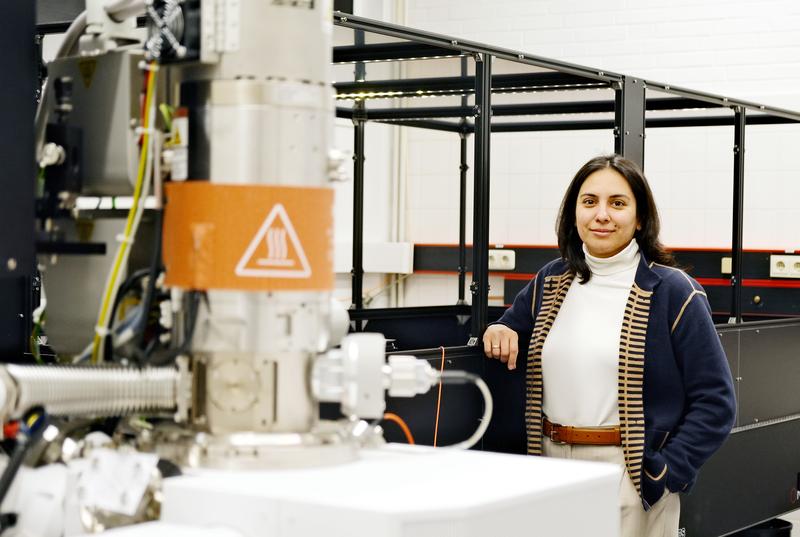About 920,000 euros for the next generation of electron microscopes
Nahid Talebi receives Momentum funding of the Volkswagen Foundation for her research about quantum electrodynamics of photon-electron interactions.
Being the pioneer of electron-photon interactions beyond non-recoil approximation, Professor Nahid Talebi and her group “Nanooptics” at Kiel University now set for a series of novel experiments and theoretical modeling that have the potential to revolutionize our understanding of how electron wave packets in electron microscopes interact with mater. Particularly, funded by the Volkswagen Foundation, QuSensEM (Quantum Sensitive Measurements with Electron Microscope) is about to establish research areas around the topics of the quantum features of the generated light in interaction with electrons and different structures. The Volkswagen Foundation is providing 926,200 euros as part of its "Momentum" funding programme for professors at the beginning of their careers. Talebi is the first scientist at Kiel University to receive this funding.
Pioneering work on the interaction of photons and electrons
"I am very happy about this funding. It enables me to take a new step in my research and strengthen my team activities," says Nahid Talebi. In 2019, the physicist took up her first professorship at Kiel University and built up her working group “Nanooptics”, equipped her own laboratories and established her teaching. This is where the Volkswagen Foundation's "Momentum" programme comes in: It wants to give researchers more freedom for creative research and teaching as well as for advancing the content and strategic development of their first tenured professorship. Talebi has been working on ultrafast electron microscopy for ten years and has already done pioneering work in this booming field of research. She combines theoretical and experimental approaches and has already received several grants from the European Research Council.
Electron microscopes are not only fascinating tools for imaging the matter at an ultrahigh spatial resolution, but also recently enabled characterizing the dynamics of such interactions using a combination of light sources and optical/electron beams characterization techniques. Talebi has approached the field of Ultrafast Electron Microscopy from two unique standing points: On the one hand, she has pioneered a numerical scheme based on the combination of Maxwell’s and Schrödinger’s equations to simulate the dynamics of electron-light-matter interactions in electron microscopes (Phys. Rev. Lett. 125 (2020) 080401). On the other hand, she has developed and realized an experimental platform for mapping the decoherence dynamics of material excitations such as single-photon emissions from defect centers (arXiv:2404.09879) and exciton polaritons (Nature Physics 19 (2023) 869-876).
Creating a tool box to explore quantum processes in their full details
Within the concept of the Momentum application, Talebi aims at extending the research in her group toward full quantum electrodynamics explorations with a combination of theoretical and experimental explorations. “Electrons interacting with many optical systems lead to single-photon generation on demand,” mentioned Prof. Talebi. In her projects she addresses questions such as the quantum-ness of the light generated via electrons interacting with various optical systems, the number of the photons generated, and the entanglement between them. “And this process can be controlled precisely by the position at which the electron interacts with the sample. In contrast with other sources such as quantum dots and defect centers, the interaction position of electron beams with samples can be controlled precisely with advanced electron optics.”
Hence, combining electron microscopes with advanced photonic systems and understanding the effect of the shape of the electron beams on the properties of the generated photons could enable advanced quantum-sensitive measurements and quantum-optics explorations with electron microscopes, says Talebi. “Merging this with ultrafast electron microscopy, leads to a toolbox for exploring quantum processes in their full details in time, energy, and space.”
Wissenschaftlicher Ansprechpartner:
Prof. Dr. Nahid Talebi
Professor for nanooptics
Institute of Experimental and Applied Physics, Kiel University
49 431 880-3388
talebi@physik.uni-kiel.de
http://www.physik.uni-kiel.de/de/institute/ieap/ag_talebi/arbeitsgruppe-prof.-dr.-talebi
Weitere Informationen:
https://www.uni-kiel.de/en/details/news/072-momentum link to the press release and publications
http://www.volkswagenstiftung.de/en/funding/funding-offer/momentum-funding-recently-tenured-professors More on the funding programme
https://www.uni-kiel.de/en/research/priority-research-areas/kiel-nano-surface-and-interface-science Website of KiNSIS, one of CAU's priority research areas
Ähnliche Pressemitteilungen im idw


